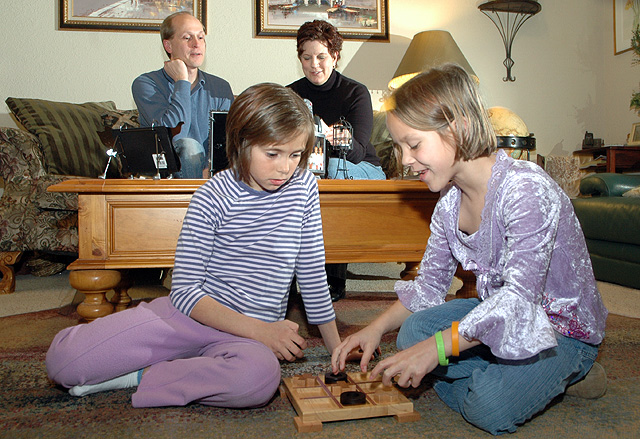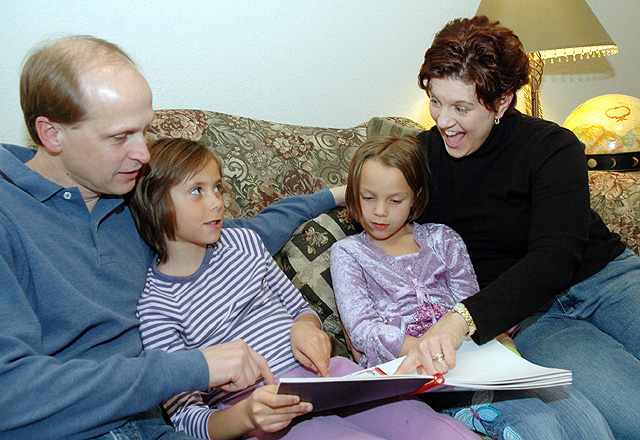Adoptions [without] borders
Parents say international route presents fewer roadblocks in journey toward happy families
Alena Johnson remembers snapshots from her time in Russia – a caretaker, a playground slide often covered with ice, the Russian word for “hello.”
And she remembers the most important detail.
“In Russia,” she says, “we didn’t have any parents.”
In 2002, Alena, 7, and her sister Anya, 9, found parents half a world away – Jeff and Kathleen Johnson of Lawrence. The girls were among the more than 22,000 children from foreign countries adopted annually by Americans.
“It just kind of spoke to us,” Kathleen Johnson says of adopting from Russia. “People say when you meet the guy you’re going to marry, or your spouse, you know. We just felt right about it.”
Challenging process
Dianne Atteberry, director of Children’s Hope International, an adoption agency in Overland Park, says adopting abroad is rarely a first choice for parents.
But if fertility treatments don’t work, parents tend to look to adoption. And adopting from other countries offers two benefits: You’re helping children who otherwise might stay in orphanages, and there’s no chance birth mothers can reclaim the child.

Jeff and Kathleen Johnson, Lawrence, have two daughters, Anya, 9, left, and Alena, 7, they adopted from Russia. The two girls play tic-tac-toe, one of their favorites games, Wednesday night at their home.
“I think it’s the (assurance) that they’re going to get a child,” Atteberry says.
Adopting internationally isn’t a simple process, and it’s not cheap. Atteberry says typical costs for her agency, which handles adoptions in four countries, run from $17,000 in Colombia to $30,000 in Russia, for one child.
The process differs slightly with adoptions in different countries, but it always involves compiling a massive binder of paperwork – called a dossier – and undergoing criminal background checks and psychological examinations. Atteberry says the quickest adoptions take a year, but most take at least 15 months or longer before parents go to the country to meet their new children.
Lawrence residents Curtis and Rochelle Marsh are well-aware of the daunting process. They started attempting to adopt two boys from Russia in January 2005 and are still four to seven months away from being matched and traveling there.
“What we’ve learned,” Curtis Marsh says, “is it is no easy task to create a citizen of a certain country. That was our way of putting it in perspective. We’re basically taking a Russian citizen and turning them into an American citizen.”

Rex and Debbie Ellebracht help their three daughters - recently adopted from Colombia - play Uno at their house in west Lawrence. The girls are, from left, Marcela, 9, Jessica, 8, and Jenny, 5.
He says it’s been difficult to be patient through the process, which is taking longer than the couple had anticipated. Russia now requires additional psychological exams that weren’t required previously, which has added to the delay.
“In January 2005, we began mentally and physically preparing ourselves to be good parents,” Marsh says. “It’s interesting. Everybody feels the same way we do: You’re never prepared to be a parent, so the wait may be a blessing. But it doesn’t negate the frustration.”
Adoption options
Prospective parents must make a series of often difficult decisions about which children they want to adopt.
First, they must decide what country they will pursue. Americans adopt the most number of children from China. Chinese girls are especially popular because of the stigma attached to having girls there.
Russia, Guatemala, Korea, Kazakhstan and Ukraine follow as the most common countries for international adoption.
Atteberry says much of that decision comes down to whether parents are willing to start a multi-racial family.

From left, Jeff Johnson, his daughters, Anya, 9, and Alena, 7, and his wife, Kathleen Johnson, look through a family photo album at their Lawrence home. The Johnsons adopted the sisters from Russia.
Couples also must request children of a certain age. Often, parents request infants, which makes their wait longer because there are more older children available.
That was part of the reason Rex and Debbie Ellebracht wanted to adopt slightly older children. In February, they returned from Colombia with three girls, ages 5, 8 and 9.
“A lot of them want a baby,” Rex Ellebracht says. “But there are kids out there – like these three – who need a good home. So we miss out on the diaper changes and the 3 a.m. feedings.”
‘It’s Christmas’
On a recent weeknight, the Ellebracht girls continue exploring their new house in west Lawrence. When their new parents picked them up in Russia, their only possessions were the clothes they were wearing.
By the numbers
Adoption statistics from 2004, the most recent data available:
There were 22,911 children adopted from foreign countries, making up about a fifth of all adoptions in the United States.
Top countries for international adoption
China: 7,033
Russia: 5,878
Guatemala: 3,252
Korea: 1,708
Kazakhstan: 824
Ukraine: 772
Gender
Male: 8,070
Female: 14,841
Age
Under 1 year: 9,195
1 to 4 years: 10,384
5 to 9 years: 2,100
Over 9 years: 1,232
Source: U.S. Citizenship and Immigration Service
The girls – Marcela, Jessica and Jenny, all biological sisters – are sorting through DVDs.
“En Español?” they ask, wondering whether the movies offer Spanish dubbing.
The girls don’t speak much English, but the Ellebrachts figure that will change quickly. The youngsters are enrolled in an English as a second language school in Kansas City, Kan., where Debbie Ellebracht teaches. Next year, they’ll go to school in Lawrence.
“I think every day they think it’s Christmas,” Rex Ellebracht says. “We’re waiting for them to find things around the house and explore them. Basically, they didn’t have anything. In Colombia, we gave them ice cream cones, and it was like we gave them $1 million.”
Didn’t miss out
Jeff and Kathleen Johnson, who adopted their Russian girls four years ago, remember the first time they met them. The couple didn’t speak much Russian, and the girls didn’t know any English.
“When I first met them, I knew we were in trouble,” Kathleen Johnson says.
But they say their older daughter picked up English in about a month, and their younger daughter learned in about three months.
From the start, they say, they felt like they made the right decision.
“Just everything in the beginning was really neat,” Kathleen Johnson says. “I remember the first time we went through a car wash, they just laughed hysterically because they’d never been in one before. You don’t realize they’d never seen that before.
“I don’t think we missed out. People say you won’t bond, but you do.”

